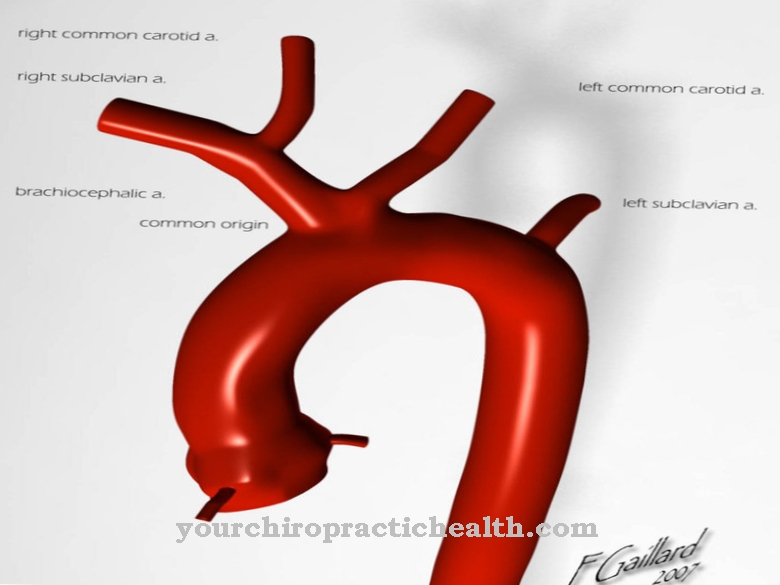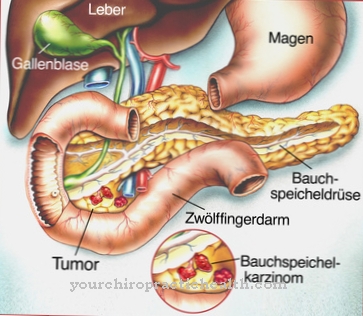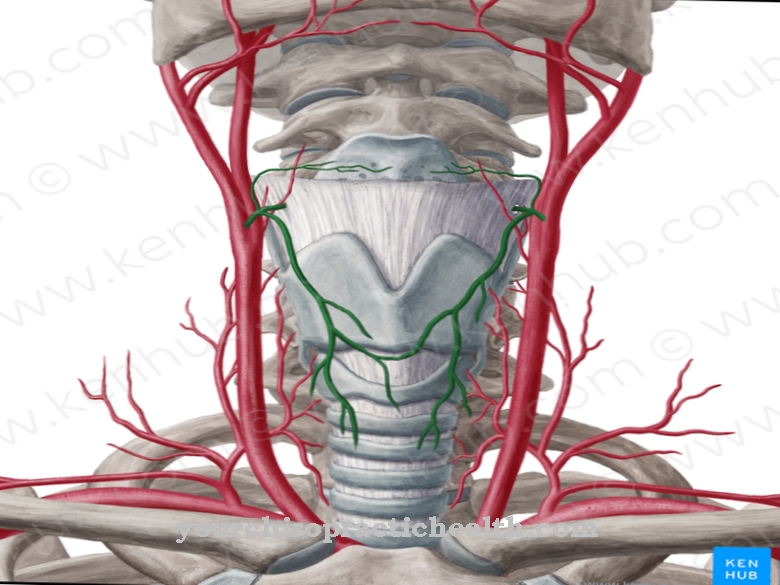The Cervical vertebrae differ from the other vertebrae in the human body: Since this area of the spine has to meet special requirements, the shape of some cervical vertebrae is also special - the vertebrae of the cervical spine are truly unique. The cervical spine is very flexible, but also sensitive. External influences can have far-reaching consequences.
What are cervical vertebrae
The seven Cervical vertebrae of humans form the cervical spine (cervical spine). This connects the head with the trunk. If the person is healthy, the cervical spine bends slightly forward; In technical jargon, this is known as "physiological lordosis". The first cervical vertebra carries the skull, after the seventh cervical vertebra the thoracic spine begins.
In medicine, the cervical vertebrae are also known as C1 to C7. The cervical vertebrae ensure that people can turn, bend, lean to the side and stretch their heads. Responsible for this mechanism is on the one hand the neck muscles - whereby the back muscles also have their share in it - and on the other hand the range of motion that the intervertebral joints allow.
Anatomy & structure
Some of the cervical vertebrae are so special that they have been given proper names. The first cervical vertebra is known in anatomy as the "atlas". The skull rests on it. This fact also leads to the naming by the namesake from Greek mythology. Because just as the Greek Atlas carries the world on its shoulders, the first cervical vertebra props the human head.
The second cervical vertebra of the Axis also has a special design - it is closely related to the first cervical vertebra. Together, Atlas and Axis form the head joint. The atlas, which resembles a ring, does not have a vertebral body of its own. For this, the axis has a tooth that the atlas includes. After these two unique vertebrae, the remaining five cervical vertebrae follow.
With the exception of these two, all other cervical vertebrae have the same structure as a normal vertebra - that is, there is a vertebral body, a vertebral arch that encompasses the spinal cord, a spinous process, two transverse processes and four articular processes are also present. A special characteristic can also be made out for the 7th cervical vertebra.
He is known by the name Vertebra prominent, which means something like "protruding vortex". Its spinous process protrudes further over the spine than is usual with the rest of the vertebrae. Due to this feature, the 7th cervical vertebra is a landmark on the spine. Thanks to its special shape, it is both clearly visible and palpable.Function & tasks
The head joint, which consists of atlas and axis, enables the person to nod and turn his head thanks to its design. The appearance is individual; There are no differences in function to other vertebrae.
There are intervertebral discs between all vertebrae, and the cervical vertebrae are no exception. An important function of the vertebrae is that they provide protection for the blood and nervous systems. The transverse processes of the cervical spine enclose a hole through which the arteriae vertebrales (vertebral artery) flow into the head on both sides.
In combination with the carotid arteries, this ensures the blood supply to the brain. The vertebral arch and vertebral body form a vertebral hole that surrounds the spinal cord. In addition, two adjacent vertebrae form an intervertebral hole through which the spinal nerves emerge from the spinal cord.
In the cervical spine, there are eight nerve cords, although there are only seven vertebrae - this is another special feature of the cervical spine, because the number of spinal nerves always corresponds to the number of vertebrae. The spinal nerves of the cervical spine are responsible for the neck, the throat muscles, the diaphragm and breathing, the chest and arm muscles and the sensitivity of the associated skin.
Damage in the area from C4 would result in the human being unable to move his arms. And if the nerve damage is higher up in the cervical spine (C1-C4), then the person affected can no longer breathe independently.
You can find your medication here
➔ Medicines for back painIllnesses & ailments
Problems and restrictions that have their origin in the cervical spine are grouped under the collective term cervical spine syndrome. Typical symptoms are neck pain, tension and muscle hardening, which, depending on the severity, can also impair arm function.
The head area can also be affected by a cervical spine syndrome with headache, nausea, dizziness, visual disturbances and hearing problems. Neurological abnormalities are: tingling, numbness and in the worst case paralysis. When it comes to the cause of the syndrome, a distinction is made between acute and chronic.
Acute HSW syndromes occur due to drafts, excessive strain (poor posture or too much physical activity) and injuries. Whiplash after a traffic accident is a typical example of an acute cervical spine syndrome. If cervical spine syndromes are chronic, the cause is a degenerative change in the cervical vertebra. In this context, disc changes, scolioses, rheumatoid arthritis, Scheuermann's disease, ankylosing spondylitis and metabolic disorders such as osteoporosis are conceivable.
A fracture of a cervical vertebra can have fatal consequences. Massive injuries to the spinal cord lead to paraplegia, which affects the human respiratory function in this area. The first measure in case of instabilities in the neck area is therefore always to put on a cervical splint, which fixes the cervical spine. Lighter acute problems of the cervical spine, which result from tension and are also popularly known as "stiff neck", usually subside on their own after a few days.













.jpg)

.jpg)
.jpg)











.jpg)